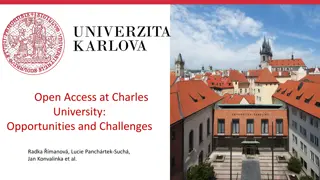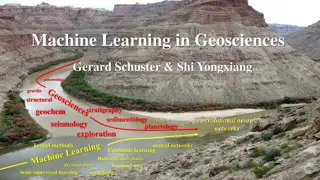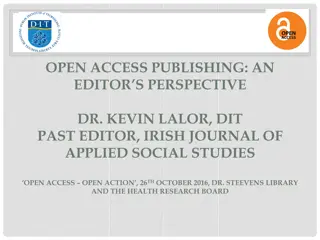Evolution of Open Access Publishing in Geosciences
Open Access trends in geosciences show a progressive shift towards immediate and delayed OA models. The introduction defines Gold, Hybrid, and Green OA, highlighting the accessibility of scholarly articles through various platforms. The geosciences field is well-defined, encompassing a wide range of disciplines, with a significant number of OA journals available for research dissemination.
Download Presentation

Please find below an Image/Link to download the presentation.
The content on the website is provided AS IS for your information and personal use only. It may not be sold, licensed, or shared on other websites without obtaining consent from the author.If you encounter any issues during the download, it is possible that the publisher has removed the file from their server.
You are allowed to download the files provided on this website for personal or commercial use, subject to the condition that they are used lawfully. All files are the property of their respective owners.
The content on the website is provided AS IS for your information and personal use only. It may not be sold, licensed, or shared on other websites without obtaining consent from the author.
E N D
Presentation Transcript
The Changing Landscape of Open Access Publishing in the Geosciences 2016 GSA Conference Denver, CO Amanda Bielskas, Columbia University Shaun Hardy, Carnegie Institution for Science
Introduction: Global Open Access Trends of the world s journals offer an immediate OA option of some kind. Just under of all journals across the world have adopted the hybrid model. Journals with an immediate Gold OA model accounted for just under 17% of global articles in 2014. A total of 19% of global papers published in subscription-based journals in the past two years (2013-2014) usually become freely accessible within 12 months - mainly via subject repositories like PubMedCentral. When we take Gold, Green and Delayed OA together about 18% of articles published in the last 2 years (2013-2014) were freely accessible upon publication. From: Universities, U. K. (2015). Open access factsheet series: monitoring the transition to open access [Internet]. London: Universities UK.
Introduction: Open Access Definitions { All content immediate free to read (authors usually pay APC) Gold OA Immediate OA Authors pay to make individual articles in subscription journals free to read Hybrid OA Delayed OA All content becomes free to read after some period of time (6-48 months) Self-archiving/posting in open repositories Green OA
Introduction: Defining Geosciences Web of Science & JCR Scopus GeoRef DOAJ Geology Geochemistry & Geophysics Geosciences, Multidisplinary Mineralogy Crystallography Paleontology Environmental sciences Soil science Engineering,geological Oceanography Meteorology & Atmospheric Sciences Earth and Planetary Sciences OA Source List: Geology (includes Mineralogy & Paleontology) Geophysics Geomagnetism Crystallography Environmental Sciences Oceanography Meteorology, Climatology Geological journals/series Related disciplines Excluded General science
Introduction: Defining Geosciences 450 OA geoscience journals (listed in one or more sources) Titles included Unique titles WoS 142 0 GeoRef 187 51 Scopus 259 21 DOAJ 305 119
Trends, 2000-2015: OA geoscience journals DOAJ relaunched with tighter inclusion policies DOAJ launched
Trends, 2000-2015: OA Geoscience Articles DOAJ relaunched with tighter inclusion policies *not cumulative - articles may appear in more than one category
Case Studies: Columbia & Carnegie: Profiles Geosciences at Columbia University Geosciences at Carnegie Institution for Science Department of Earth & Environmental Sciences Earth Institute Lamont-Doherty Earth Observatory 200 Ph.D. level researchers & 80-90 graduate students Center for International Earth Science Information Network (CIESIN) International Research Institute for Climate and Society (IRI) A number of other affiliated institutes, centers, and research areas such as Earth and Environmental Engineering, Climate Center, Water Center, many Sustainability programs and Institutes Department of Terrestrial Magnetism Geophysical Laboratory 60 staff/research scientists 40-50 postdocs & research associates Geosciences Astronomy & Astrophysics Physics & Materials Science
Case Studies: Columbia & Carnegie compared to OA geosciences overall
Case Studies: Columbia & Carnegie: OA journals, 2000-2015
Case Studies: Columbia & Carnegie Factors influencing author uptake of OA Cost: Gold OA APCs: Free $3,000 Hybrid Journal OA APCs: $250/page $5,000 Funding: Publication funds from institutions The ability to pay APCs with grant funds Impact/Familiarity: Hybrid OA uptake
Hybrid Journal Uptake: All Fields } Hybrid OA: 6.5% Gold OA: 11.4% % of all 2014 journal articles by UK authors Of the immediate OA models, uptake of the Gold-Hybrid option grew the fastest globally and in the UK [from 2012 to 2014] UK authors tend to choose more highly-cited journals for their articles compared to the world average. This may in part explain the higher take-up in the UK compared to the world average for hybrid journals. Source: Universities UK, Monitoring the Transition to Open Access (August 2015)
Hybrid Journal Uptake: Geosciences Publisher-provided data (GSA, AGU, GSL); our 10- journal sample (Elsevier, Springer)
Conclusions: No single bibliographic source identifies all OA publications The number of OA geoscience journals is increasing (new journals and journals converting to OA) The % of OA journal articles in the geosciences is increasing No significant differences in impact factors between OA and geoscience journal overall is evident Adoption of Gold OA by Columbia and Carnegie authors is increasing, but still accounts for a small % of overall output Geoscience publishers are seeing growing uptake of Hybrid OA option Hybrid OA is the fastest growing OA publishing mode globally
www.geoinfo.org/openaccess.html Amanda Bielskas: asb2154@columbia.edu Shaun Hardy: shardy@carnegiescience.edu























